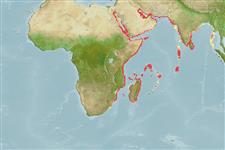>
Eupercaria/misc (Various families in series Eupercaria) >
Nemipteridae (Threadfin breams, Whiptail breams)
Etymology: Scolopsis: Name from the Greek masculine noun 'skolos' meaning 'thorn' and suffix '-opsis' (from Greek feminine n. 'opsis' meaning 'aspect', 'appearance') meaning ‘thorny appearance’ presumably referring to 'les dentelures de la préopercule, en ont aussi, et même d'épineuses, aux sous-orbitaires' mentioned by Cuvier (1814) in his designation of the genus. Name ending in -'opsis' are treated as feminine according to ICZN 1999: Article 30.1.2 (Ref. 130620).
Environment: milieu / climate zone / rango de profundidad / distribution range
Ecología
marino asociado a arrecife; rango de profundidad 1 - 20 m (Ref. 9710). Tropical; 31°N - 33°S, 31°E - 95°E (Ref. 3810)
Indian Ocean: Red Sea, Persian Gulf, Gulf of Oman and East Africa (up to Delagoa Bay) to Madagascar and the Andaman Islands.
Tamaño / Peso / Age
Madurez: Lm ? range ? - ? cm
Max length : 30.0 cm TL macho / no sexado; (Ref. 30573); common length : 12.0 cm SL macho / no sexado; (Ref. 3810)
Espinas dorsales (total) : 10; Radios blandos dorsales (total) : 9; Espinas anales: 3; Radios blandos anales: 7. Head scales reaching forward to level of middle of eyes. Lower limb of preopercle naked. Antrorse (forward-directed) suborbital spine absent. Pelvic fins long, reaching to or just beyond level of anus. Axillary scale present. Color: Numerous black or dark brown spots on sides forming stripes with white interspaces between. A pearly-white stripe from below eye to upper edge of pectoral base.
Body shape (shape guide): fusiform / normal; Cross section: oval.
Benthic, found in inshore waters usually on shallow sandy bottoms close to coral reefs (Ref. 30573). Feeds on crustaceans, mollusks, echinoderms and fishes (Ref. 30573).
Life cycle and mating behavior
Madurez | Reproducción | Puesta | Huevos | Fecundidad | Larva
Russell, B.C., 1990. FAO Species Catalogue. Vol. 12. Nemipterid fishes of the world. (Threadfin breams, whiptail breams, monocle breams, dwarf monocle breams, and coral breams). Family Nemipteridae. An annotated and illustrated catalogue of nemipterid species known to date. FAO Fish. Synop. 125(12):149p. Rome: FAO. (Ref. 3810)
IUCN Red List Status (Ref. 130435: Version 2025-1)
Threat to humans
Harmless
Human uses
Pesquerías: pesquerías de subsistencia; Acuario: Comercial
Herramientas
Special reports
Download XML
Fuentes de Internet
Estimates based on models
Preferred temperature (Referencia
123201): 25.1 - 29.1, mean 27.6 °C (based on 803 cells).
Phylogenetic diversity index (Referencia
82804): PD
50 = 0.5000 [Uniqueness, from 0.5 = low to 2.0 = high].
Bayesian length-weight: a=0.01660 (0.00747 - 0.03689), b=2.98 (2.81 - 3.15), in cm total length, based on LWR estimates for this Genus-body shape (Ref.
93245).
Nivel trófico (Referencia
69278): 4.0 ±0.36 se; based on food items.
Resiliencia (Referencia
120179): Alto, población duplicada en un tiempo mínimo inferior a 15 meses (Preliminary K or Fecundity.).
Fishing Vulnerability (Ref.
59153): Low vulnerability (20 of 100).
🛈
Nutrients (Ref.
124155): Calcium = 56.5 [35.9, 116.3] mg/100g; Iron = 0.645 [0.314, 1.592] mg/100g; Protein = 19.1 [17.2, 20.8] %; Omega3 = 0.138 [0.083, 0.229] g/100g; Selenium = 25.4 [14.8, 45.8] μg/100g; VitaminA = 76.1 [21.3, 222.4] μg/100g; Zinc = 1.26 [0.87, 1.82] mg/100g (wet weight);
